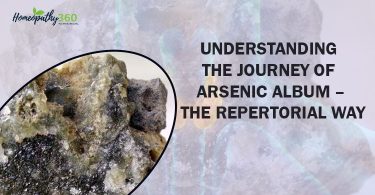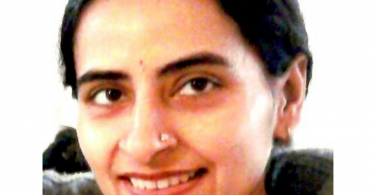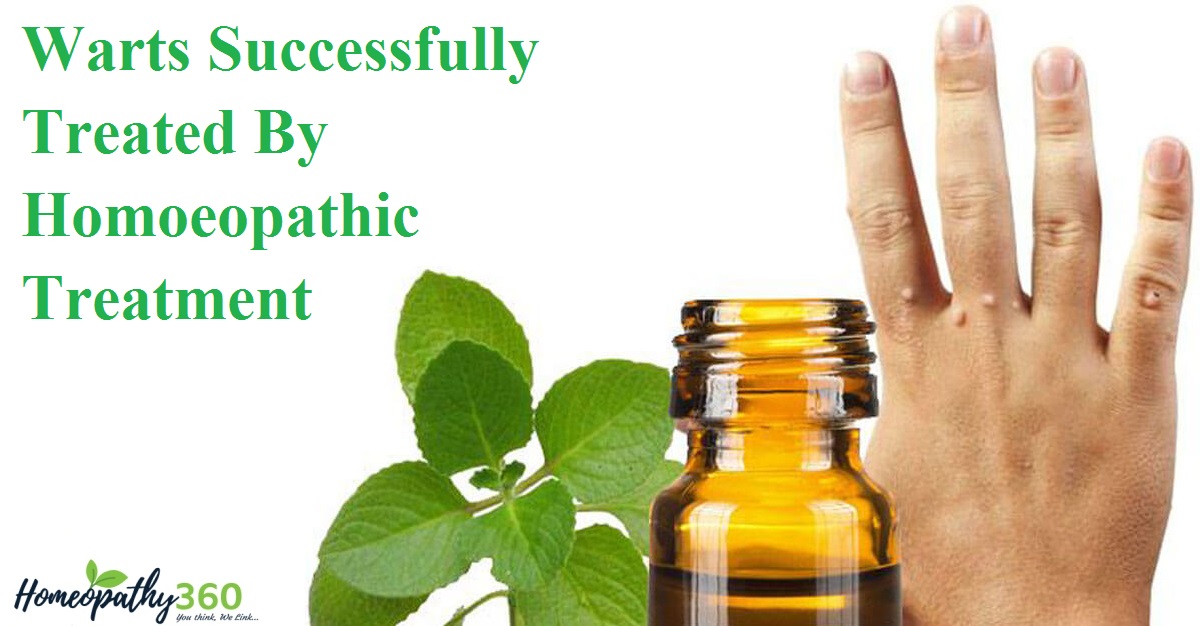
Introduction
A small fleshy bump on the skin or the mucous membrane caused by human papillomavirus. Warts are caused by various strains of human papillomaviruses. Different strains may cause warts in different parts of the body. Warts can be spread from one location on the body to another or from person to person by contact with the warts. The main symptom is a fleshy, painless growth on the skin. Common areas affected include the hands, feet and genitals. Treatment may include medication and removal through medical procedures.
How do dermatologists diagnose warts? According to Dermatologist
A dermatologist can tell whether you have a wart by looking at it. In rare cases, a dermatologist may need to perform a skin biopsy to be certain. If a dermatologist needs to perform a biopsy, the doctor will remove the wart and send it to a lab. At the lab, a small piece of the wart will be looked at under a microscope.
Warts are a nuisance to many people. Hence, they seek the help of skin experts. Dermatologists do treat them by employing various methods to remove warts and prevent their recurrence. One common approach is applying salicylic acid to the affected area, breaking down the layers of the wart over time. Check more aggressive treatment methods below.
How do dermatologists treat warts? According to Dermatologist
Warts often go away without treatment. This is especially true when children get warts. In adults, warts may not disappear as easily or as quickly as they do in children. Although most warts are harmless, dermatologists do treat them.
You should see a dermatologist if you cannot get rid of the warts, the warts hurt, or you have many warts. Dermatologists have many treatments for warts. The treatment used depends on the patient’s age and health as well as the type of wart.
A dermatologist may use one of the following treatments:
- Cantharidin: A dermatologist may treat a wart in the office by painting it with cantharidin. Cantharidin causes a blister to form under the warts. In a week or so, you can return to the office and the dermatologist will clip away the dead wart.
- Cryotherapy: For common warts in adults and older children, cryotherapy freezing is the most common treatment. This treatment is not too painful. It can cause dark spots in people who have dark skin. It is common to need repeat treatments.
- Electro surgery and curettage: Electro surgery burning is a good treatment for common warts, filiform warts, and foot warts. Curettage involves scraping off (curetting) the wart with a sharp knife or small, spoon-shaped tool. These two procedures often are used together. The dermatologist may remove the wart by scraping it off before or after electro surgery.
- Excision: The doctor may cut out the wart excision.
If the warts are hard-to-treat, the dermatologist may use one of the following Treatment
- Laser treatment: Laser treatment is an option, mainly for warts that have not responded to other therapies. Before laser treatment, the dermatologist may numb the wart with an anesthetic injection shot.
- Chemical peels: When flat warts appear, there are usually many warts. Because so many warts appear, dermatologists often prescribe “peeling” methods to treat these warts. This means, you will apply a peeling medicine at home every day. Peeling medicines include salicylic acid (stronger than you can buy at the store), tretinoin, and glycolic acid.
- Bleomycin: The dermatologist may inject each wart with an anti-cancer medicine, bleomycin. The shots may hurt. They can have other side effects, such as nail loss if given in the fingers.
- Immunotherapy: This treatment uses the patient’s own immune system to fight the warts. This treatment is used when the warts remain despite other treatments. One type of immunotherapy involves applying a chemical, such as diphencyprone (DCP), to the warts. A mild allergic reaction occurs around the treated warts. This reaction may cause the warts to go away. Another type of immunotherapy involves getting shots of interferon. The shots can boost the body’s immune system, which gives the body the ability to fight the virus.
Outcome
There is no cure for the wart virus. This means that warts can return at the same site or appear in a new spot. Sometimes, it seems that new warts appear as fast as old ones go away. This happens when the old warts shed virus cells into the skin before the warts are treated. This allows new warts to grow around the first warts. The best way to prevent this is to have your dermatologist treat new warts as soon as they appear.
According to Homoeopathy warts are chronic one sided disease. According to our Master Dr.C.F.S Hahnemann Natural chronic disease Naturally cure bye the homoeopathic medicine and orthodox school are spoils the natural chronic disease into more worse condition of the patient. They can shift superficial natural disease into deep and more vital organs of the body and ultimately they removed partially or fully the vital organs of a patient by surgery which caused a permanent loss of vital organ of the patient Dr.Hahnemann says in his book ‘The Chronic Disease Their Peculiar Nature and Their Homoeopathic Cure’ chronic disease cause by chronic Miasm.
Dr.J.H.Allen also discuss about chronic disease and the chronic miasm in his book ‘The Chronic Miasms with Repertory’. We consider mainly the sycotic miasma is the background of warts cases extra growth cases.
Classification of warts
Histopathology
Common wart (Verrucca vulgaris)
Histopathology features include acanthosis, digitated epidermal hyperplasia, papillomatosis, compact orthokeratosis, hypergranulosis, tortuous capillaries within the dermal papillae, and vertical tiers of parakeratotic cells with red blood cells entrapped above the tips of the digitations. Elongated rete ridges may point radially toward the center of the lesion. In the granular layer, cells infected with HPV have coarse keratohyalin granules and vacuoles surrounding wrinkled-appearing nuclei. Koilocytic cells are pathognomonic.
Butcher’s
Butcher’s warts have acanthosis, hyperkeratosis, and papillomatosis. Small vacuolized cells are seen, and centrally located shrunken nuclei may be identified in clusters within the granular layer rete ridges.
Filiform
Filiform warts appear similar to common warts, but they may have prominent papillomatosis.
Focal Epithelial Hyperplasia (Heck disease)
Focal epithelial hyperplasia is characterized by acanthosis, blunting, hyperplastic mucosa with thin parakeratotic stratum corneum, anastomosis of rete ridges, and whiteness of epidermal cells due to intracellular edema. Some may have prominent keratohyalin granules, and vacuolated cells may be present.
Deep Palmoplantar
Deep palmoplantar warts are similar to common warts except the lesion lies deep to the plane of the skin surface. The endophytic epidermal growth has the distinctive feature of polygonal, refractile-appearing, eosinophilic, cytoplasmic inclusions made up of keratin filaments, forming ring like structures. Basophilic parakeratotic cells loaded with virions and basophilic nuclear inclusions and may be in the upper layers of the epidermis.
Flat
Flat warts are similar to common warts in light microscopy. Cells with prominent perinuclear vacuolization around pyknotic, basophilic, centrally located nuclei can be in the granular layer. These are referred to as “owl’s eye cells.”
Cystic
Common wart (Verrucca vulgaris)
Histopathologic features include acanthosis, digitated epidermal hyperplasia, papillomatosis, compact orthokeratosis, hypergranulosis, tortuous capillaries within the dermal papillae, and vertical tiers of parakeratotic cells with red blood cells entrapped above the tips of the digitations. Elongated rete ridges may point radially toward the center of the lesion. In the granular layer, cells infected with HPV have coarse keratohyalin granules and vacuoles surrounding wrinkled-appearing nuclei. Koilocytic cells are pathognomonic.
Butcher’s
Butcher’s warts have acanthosis, hyperkeratosis, and papillomatosis. Small vacuolized cells are seen, and centrally located shrunken nuclei may be identified in clusters within the granular layer rete ridges.
Filiform
Filiform warts appear similar to common warts, but they may have prominent papillomatosis.
Focal Epithelial Hyperplasia (Heck disease)
Focal epithelial hyperplasia is characterized by acanthosis, blunting, hyperplastic mucosa with thin parakeratotic stratum corneum, anastomosis of rete ridges, and whiteness of epidermal cells due to intracellular edema. Some may have prominent keratohyalin granules, and vacuolated cells may be present.
Deep Palmoplantar
Deep palmoplantar warts are similar to common warts except the lesion lies deep to the plane of the skin surface. The endophytic epidermal growth has the distinctive feature of polygonal, refractile-appearing, eosinophilic, cytoplasmic inclusions made up of keratin filaments, forming ring like structures. Basophilic parakeratotic cells loaded with virions and basophilic nuclear inclusions and may be in the upper layers of the epidermis.
Flat
Flat warts are similar to common warts in light microscopy. Cells with prominent perinuclear vacuolization around pyknotic, basophilic, centrally located nuclei can be in the granular layer. These are referred to as owl’s eye cells.
Homoeopathic Treatment
According to homoeopathy we treat the patients not the disease. Choice of remedy depend upon totality of symptoms consider with miasmatic background, constitution, modalities, diet and regiment, environmental conditions, mental and social economical conditions
A Case of Skin Tag
Name: Mr P.Singhal Age: 55 S/O Mr.Singhal Add: Resident of Agra Occupation: Writer/Journalist
Sex:-Male Religion:-Hindu B.P:-130/85mmhg Pulse: 78/Mint Wt.: 71kg Diet: – Vegetarian
P/C- Chief complaint
Location :-Skin wart at the dorsal part of the neck, since 2010.
Sensation :-Hard on touch
Modality :-Slight Itching with burning sensation some times.
Causation:-
Scratching violently at left neck region
H/O-
Pain at Epigastric region region
Previously burning in micturition.àUrinary Tract Infection
Diagnosis: – UTI
Past History:-
Parents was not so supportive to him and his wife
Finical loss due as his younger brother has stolen all the wealth earns by him and his parents.
Loss of Business à Life situation.
Family History:-
Father:-DM 2, Dead due to Heart Attack
Mother :-Dead Due to Heart Attack
Personal:-
Smoker since 20 Years
Tabaco Chewing since 20 Years
Alcohol Occasionally
Irregular diet
Highly seasoned food
Fatty food
Physical Generals:-
Appetite: – Not Good Acidity, Sour Belching, Heaviness In Abdomen After Eating Flatulence.
Desire: – Tea 6 to 7 times a day, and sweats any kind of
Intolerance: – of cold
Thirst: – 7lt to 8lt /day all weather.
Stool: – Can’t pass until feels pressure.
Urine: – Irritable while micturition
Passes the urine 4 to 6 times/day
Sleep: – 5hrs to 6 hrs. un refreshing and in complete
Dreams: – As if someone in giving advice to him to do so.
Mental:-
Anger Expressed
Industrious
Anarchist
Superstitious
Modalities:-
Aggravation: – during Morning
Amelioration:-Warm and completing his work
03/02/2020
Totality of the case:-
Loss of Business
Smoking
Highly Seasons food
Desire of stimulants
Industrious
Repertory: – Radar 10, Synthesis Repertory 8.1
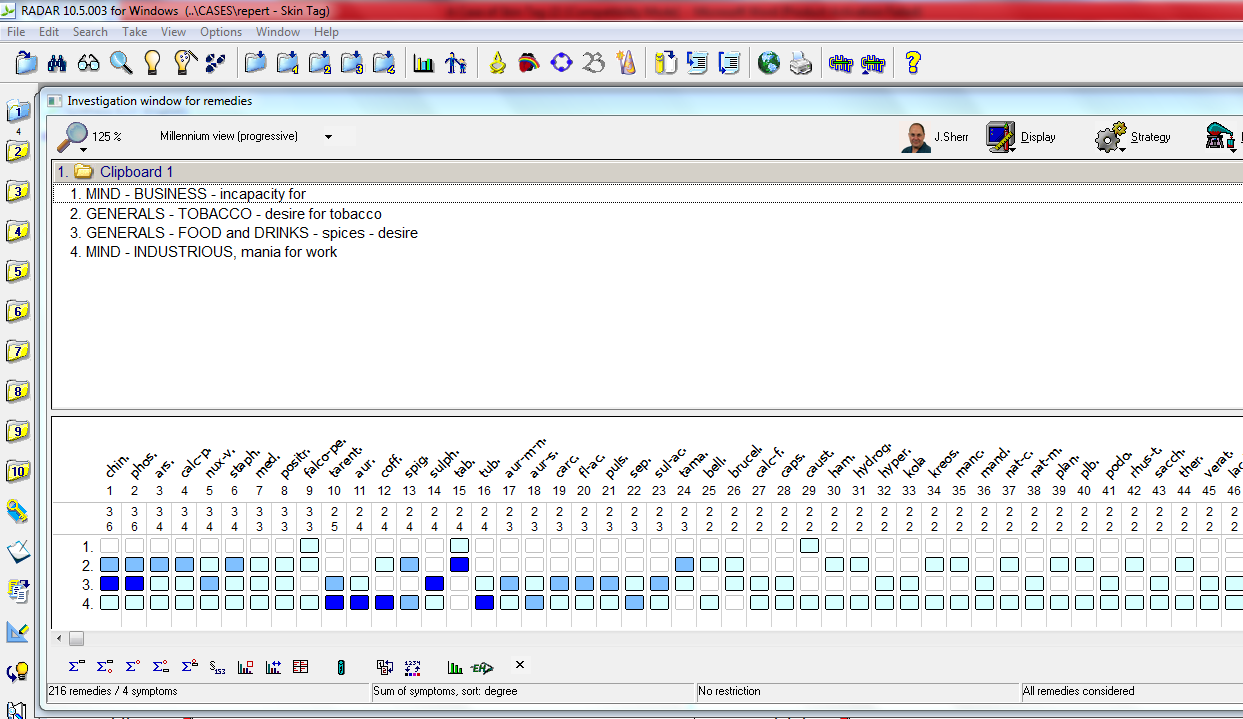
Rx
Nuv Vomica 1M 1 dose at bed time in Sugar of Milk
Placebo 3 Pills Three times a day
Follow up criteria:-After every 15 days
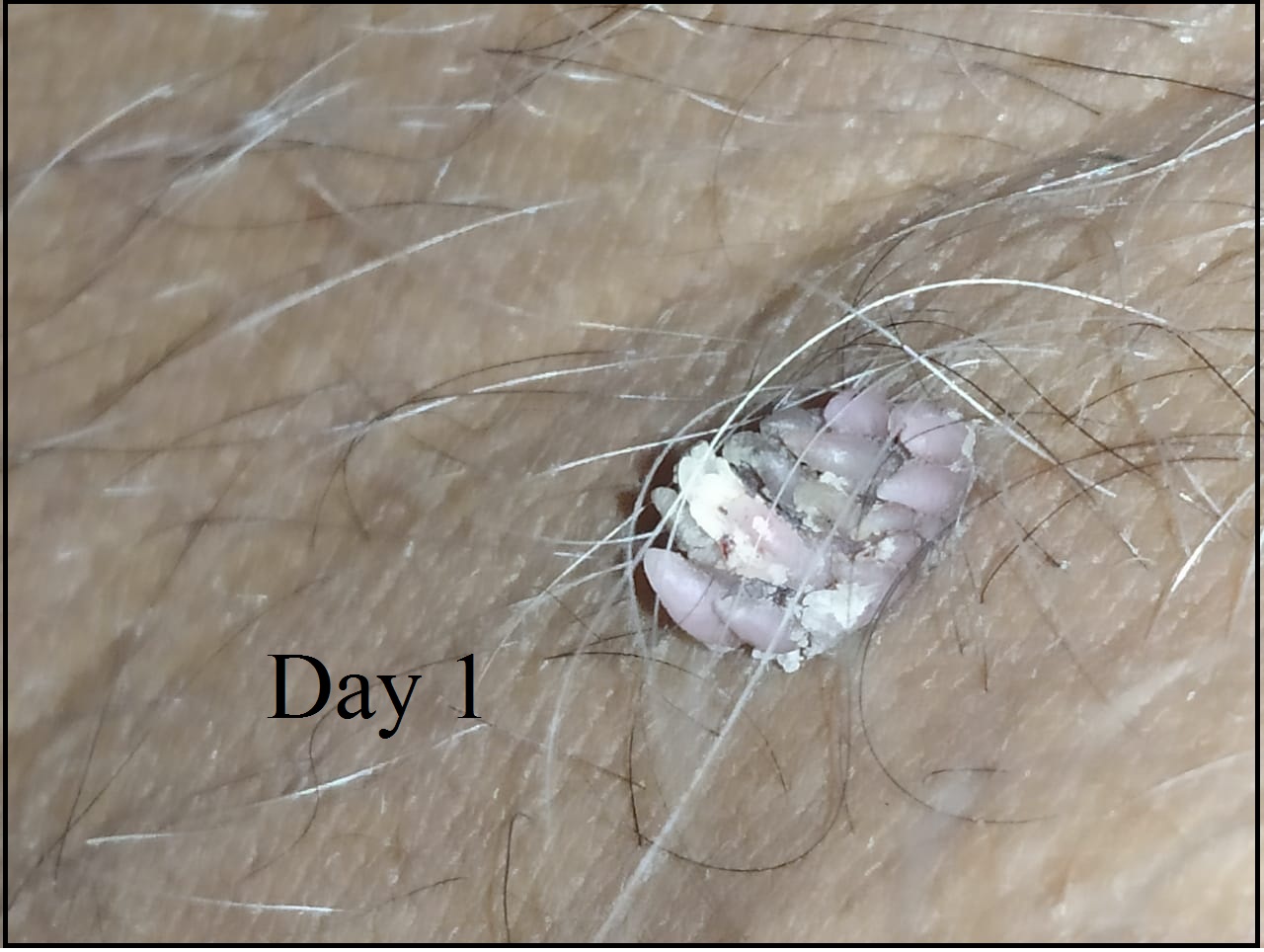
Selection of remedy
I select Very common medicine and normally used by common people for gastric complaints “Nux Vomica”, According to the symptoms similarity and repertory
Follow UP
Follow up on. I
The size was reduced
Burning in urine is increased and flow also
Feeling of Drowsiness at evening time
Weakness all day
Sleeplessness
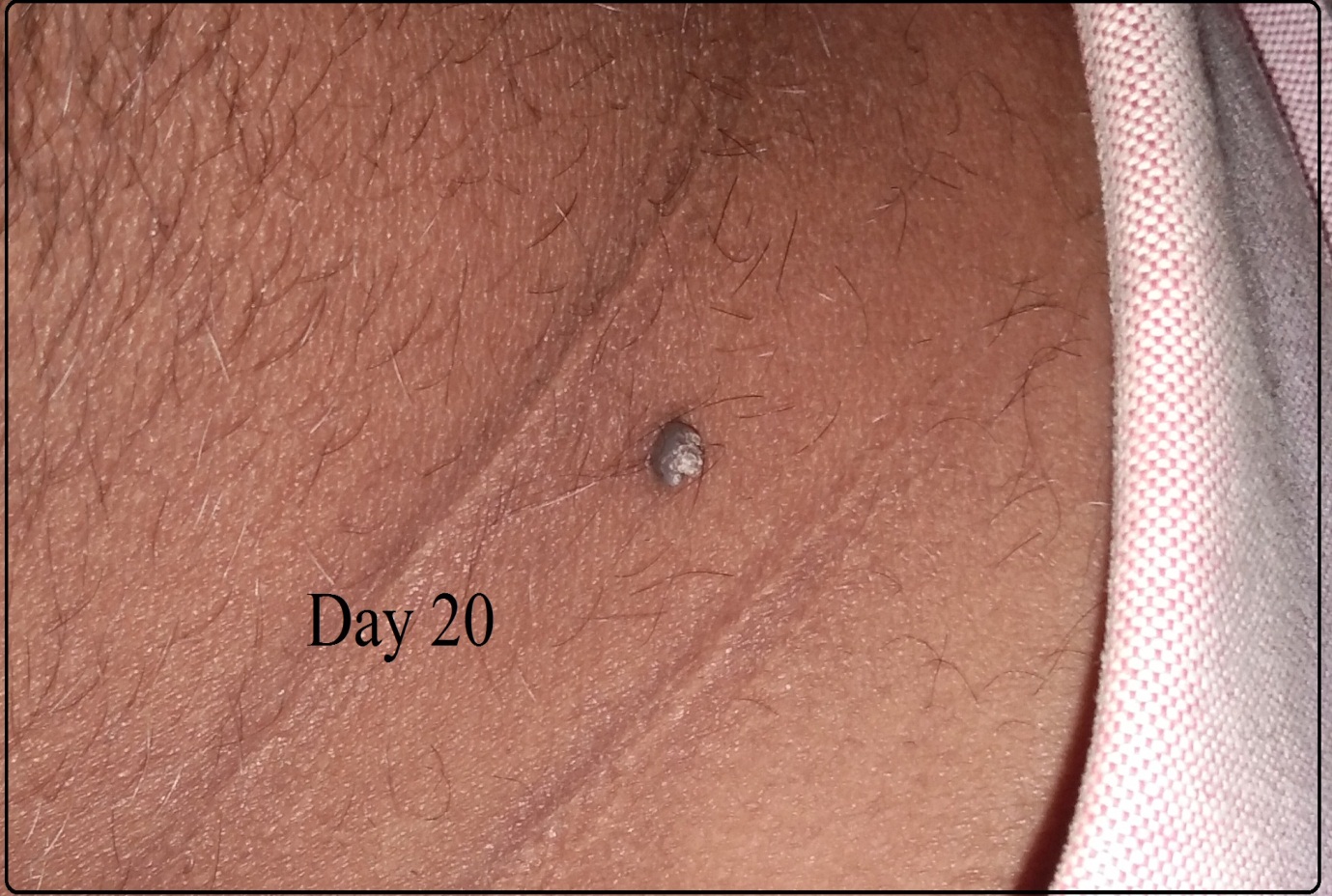
Follow up on II
The size was pretty much reduced
Burning in urine is less but flow is as same
Drowsiness at evening time continued
Appetite increased
Thirst is increased
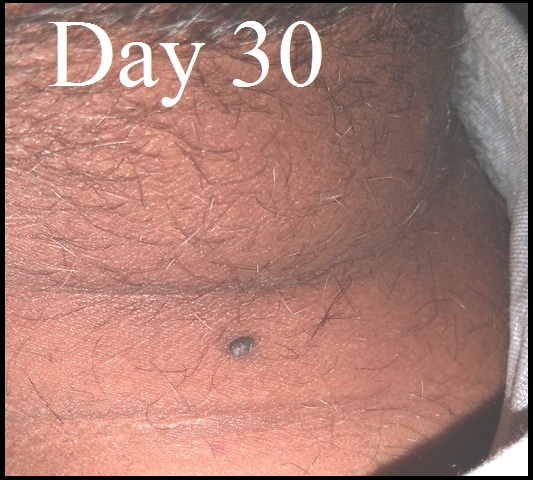
Follow up on III
Day 50
The size was continued to reduced
Burning in urine is better and flow also better
Feeling of Drowsiness at evening time is better
Weakness all day present
Sleeplessness better
Appetite normal
Thirst is normal 3lt to 4lt /day
Follow up on IV
The size was continued to reduced
Burning in urine is better and flow also better
Feeling of Drowsiness at evening time is better
Weakness all day present
Sleeplessness better
Appetite normal
Thirst is normal 4lt to 6lt /day
Completely Relieved in all symptoms
Conclusion
I like to say warts can easily remove without any operation by the homoeopathic treatment without any palliation this case as you can see how a simple medicine can be power full if the selection is correct.
As the great master Dr.Hahnemann says in his Organon of medicine as in aphorisms that how to treat and how to restore sick to health by following his route of Seven Cardinal Principles of homoeopathy for betterment of the society and patient.
Abstract
During this case taking I was thinking that why the wart come along on the neck and the left side only. After gradually knowing that in this case the finical issue was raised in his life during 2009 and his parent was no so much supportive as he was suppressing his emotions against them specifically with mother after father’s death she was head of family as in Dr.Hamer’s theory the biological conflicts as left side not being able to eliminate a biological conflicts of the disfigurement conflict was present.
Bibliography
Books:-
Keynotes and Characteristics with Comparison of some of the leading remedies of the Materia Medica by H.C. Allen, MD
Materia Medica by John Henry Clarke.IBPPA Dictionary Of Practical Materia Medica (3 Volumes) Hardcover – Large Print, 1 January 2005 by John Henry Clarke
Pocket Manual of Homoeopathic Materia Medica By William Boericke.
Organon of Medicine by Samuel Hahnemann (5th and 6th Edition B.Jain Publisher P LTD).
The Chronic Disease Their Peculiar Nature and Their Homoeopathic Cure.
The Chronic Miasms with Repertory.
Illustrated Synopsis of Dermatology & Sexually Transmitted Diseases Neena Khanna.
Hutchison’s Clinical Methods, International Edition – An Integrated Approach to Clinical Practice With STUDENT CONSULT Online Access (English, Paperback, MA, MD, FRCP, FHEA, ILTM Dr.Glynn Michael).
Harrison’s Principles of Internal Medicine – 20th Edition: – Volume I & Volume IIby J. Larry Jameson (Author), Anthony S. Fauci (Author), Dennis L. Kasper (Author), Stephen L. Hauser (Author), Dan L. Longo (Author), Joseph Loscalzo (Author).
Bailey & Love’s Short Practice Of Surgery, 27th Edition.
Bailey & Love’s Short Practice of Surgery, 27th Edition: Paperback: Taylor & Francis.
Website:-
www.pmj.bmj.com
www.ijrh.org
www.healthline.com
www.aad.org/public/diseases/a-z/warts-treatment
https://www.ncbi.nlm.nih.gov/books/NBK431047
About Author:
Dr.Ishan Paul MD (Hom) Scholar( Part I)
Naiminath Homoeopathic Medical College Hospital and Research Centre, Agra (U.P)


